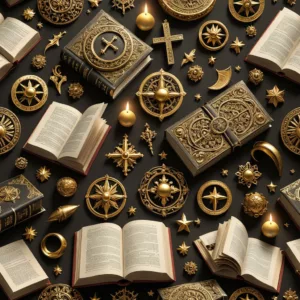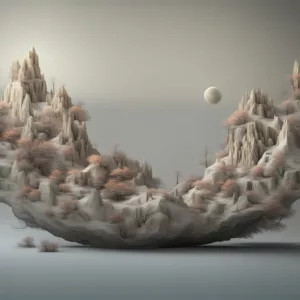Magga / Marga, the 4th Noble Truth is the path to cessation of suffering by meditation, study, and contemplation of the Buddha’s teachings. The path includes various categories: 5 paths, 10 bhumis, 8-fold path, 4 Noble Truths, and 9 yana path, among others.
Table of Contents
4 Noble Truths of Buddhism
| English | Sanskrit | Sanskrit |
| Life is Suffering | dukkha | 3 types – conditioned existence, attachment, all-pervasive |
| Origin of suffering is attachment | taṇhā | 5 skandhas, 12 nidanas |
| Cessation of suffering | Nirvana | Extinction of craving, realizing non-self, no rebirth |
| Path | Marga | Meditation, 8-fold path, non-returning |
Path to Cessation

The path is essentially meditation on the correct view as expressed by the Buddha. Reading this post right now is part of the path of the 4 Noble Truths. Taking Refuge, learning about selflessness, and concentration on the components of reality: skandhas, nidanas, etc.
What is magga in Buddhism? What it essentially comes down to is developing the skill of meditation, continually refining the view of not-self (Hinayana) and the 2 truths, absolute and relative (Mahayana).
Doing the particular meditations of the Shravaka (Hinayana), one can see the temporary arising and disappearing of the 5 skandhas, the individual instants of consciousness. The seeming solidity of self, created by the constant blur of motion and mental activity, is stopped.
How do you walk the path of Buddhism?
You walk the path of Buddhism by
- Taking Refuge in the 3 jewels
- Studying the view of not-self and meditating on that
- If inspired, taking the bodhisattva vow
- Studying and meditating on emptiness
- If inspired, moving on to Vajrayana
One of the primary approaches of the Hinayana practitioners is to closely examine the 12 nidanas and arrest the flow at the 7th, craving. Craving arises in the mind unbidden. It is the result of the past karma. That habit of wantingness arises at the thought of the thing. It can be triggered by mention, seeing, or simply from the mind.
At that point, craving arises in the mind. It cannot be prevented from coming up. Craving can also mean craving for something to end – pain, fear, or sickness, for example. The meditative approach is to simply look directly at the craving while in concentration, releasing it before it evolves into nidana 8 – grasping. Craving is wanting, and grasping is acting to obtain. The Hinayana practitioner breaks that link, often by removing themselves from the stimulus.
How to meditate like a yogi
and enter profound samadhi
This is a good practice to do in general. It does not have to occur only in formal meditation. But a great deal of training in formal meditation at releasing craving is critical because the karma is so root-level, so powerful. If you want to have any success in overcoming it, you must practice meditation. Then it can extend into life.
It’s obviously better for the Hinayana practitioner to do this by living a simple life. To have very few things around to grasp at. The Hinayana practitioner spends a lot of time in meditation and at the time of death, releases the craving to be reborn so that it does not become grasping and lead to nidana 10 – Becoming. This cuts the cycle of rebirth.
The arhat is capable of releasing the habit of wanting a body, wanting a form. They can seat themselves in the non-being of Nirvana simply by releasing the impulse toward another birth.
What are the 4 noble truths and the eight-fold path?
The 4 Noble truths culminate in the eightfold Path of Buddhism. It’s a core component of the 4th Noble Truth.
| 8-Fold Path of Buddhism | ||
|---|---|---|
| Virtue | Description | Division |
| Right Speech | Refrain: angry, idle, divisive, or gossipy speech | Discipline |
| Right Action | No killing, stealing, or sexual misconduct | |
| Right Livelihood | 1) Not making money by wrong livelihood (killing, etc.) 2) Living according to the Noble Path of enlightenment | |
| Right Effort | Overcome negative mental states and cultivate wholesome ones | Absorption |
| Right Mindfulness | Focusing on virtue, abandoning focus on non-virtue | |
| Right Concentration | One-pointed, deepening focus on a noble object. Equanimity. | |
| Right View | Ending illusion. Seeing reality of non-self and emptiness. | Wisdom |
| Right Motivation | Renounce anger, comfort, and harm. |
4 Noble Truths in Mahayana
The 4 Noble Truths have an analog in the Mahayana in that suffering has to do with seeing the pain of others and wanting to alleviate that. The origin is seeing that others suffer needlessly because of ego. Cessation, where it becomes distinct from the Hinayana, is enlightenment in the Mahayana. This comes after the vow to bring all beings to liberation.
The difference between enlightenment on the bodhisattva path and the Hinayana path of Nirvana is that enlightenment allows one to take a form, a body, in the world and work for the liberation of others without getting caught in the illusion. The Hinayana practitioner cannot do this. They simply stop taking rebirth. The Mahayana takes rebirth and, becoming more and more enlightened, has less and less ego in action. They only act for the benefit of others until fully enlightened. Then they are immune to negative consequences. They don’t suffer because there is no self at all to be attached to. They have overcome it completely.
The Hinayana practitioner has not necessarily overcome all the karmic strains of ego. If they take rebirth to pursue the Mahayana path, they will have to deal with their latent karma, the illusion of ego, and the attendant confusions of engaging in life.
The reason is that it is far, far easier to see non-self in meditative absorption than in action. The arhat simply maintains that formal meditation after death. If they re-engage in the activities of life they cannot maintain it.
The cessation of suffering, therefore, is seeing the emptiness of all reality, all beings, and all phenomena, and stabilizing that in meditation. Directly seeing emptiness in meditation, then taking that off the cushion.
The Vajrayana path is, in some sense, primarily an accelerated means of accomplishing the Mahayana. However, it focuses more on the Shentong approach of luminosity which is the fully developed manifestation of buddha nature. It can also be called sacredness, wisdom mind, and many other names.

Flow, the profound mental state, also called Peak Performance, can be attained with meditation and can be ‘triggered’ at will, with enough discipline. Guide to Flow Mastery will teach you how.
Path of the 9 Yanas
The path of the 9 yanas or vehicles is the complete path from Hinayana to Vajrayana.
| 9-yanas | ||
| Yana | Meaning | Trait |
| Hinayana – Shravaka | Narrow way vehicle – Listeners | Follow a guide to self-liberation |
| Hinayana – Pratyekabuddha | Narrow way vehicle – Solitary Realizers | Seek liberation alone |
| Mahayana | Great way | Bodhisattva path of liberating all beings |
| Outer Tantrayana | ||
| Kriya yana | Action / activity | Purity through ritual |
| Upa Yana | Conduct | balance of outer and inner methods |
| Yoga Yana | Union | Detailed self-visualization, purification of desire, and form |
| Inner Tantrayana | ||
| Mahayogayana | Great Union | Cutting through to primal purity, the spontaneous presence of the mandala. |
| Anuyogayana | Further Yoga | Completion stage (non-form) with characteristics. Subtle body. |
| Atiyogayana | Great completion or perfection | Cutting through to primal purity, spontaneous presence of the mandala. |
Secrets of Meditation for Anxiety
Like millions of people, you may have suffered from anxiety for years. Meditation, yoga, peaceful music – it never works. It takes too long, and it’s not stable. Why? Because peace is treated as a cause for freedom, but it’s not – it’s the result. The cause to free yourself from anxiety is completely different.
Click now to Overcome Anxiety for good.
faq
What is the noble truth of the path?
The Noble truth of the path, marga / magga, is the path to cessation of suffering. It includes the study of selflessness, meditation, and the 8-fold path for mahayanists.
Why is Maga the most important noble truth?
Maga is the most important Noble Truth because it shows the way out of suffering.
Why are the 4 Noble Truths important?
The 4 Noble Truths are important as they provide the general overview and meaning for the entirety of Buddhism.
Where did the 4 Noble Truths come from?
The 4 Noble Truths came from Buddha’s first teaching, given to his former companions.
Why is the 8 fold path important?
The 8 Fold Path is important as it provides the broadest overview of a total approach to life as a serious practitioner of Buddhism.
Conclusion
The 4 Noble Truths is the most basic, essential, distilled, yet overarching teaching of the Buddha. It extends all the way to complete enlightenment. It can be practiced strictly from a Hinayana perspective but extends all the way through the ten bhumis of the bodhisattvas and provides a frame for the Vajrayana perspectives of creation / completion, samaya, and so forth. The 4 Noble Truths is the complete path of the Buddha.

May all beings be happy
May all beings be peaceful
May all beings be safe
May all beings awaken to the light of their true nature
May all beings be free







